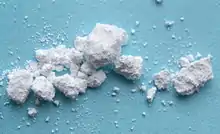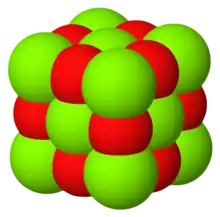 | |
 | |
| Names | |
|---|---|
| IUPAC name
Strontium oxide | |
| Other names
Strontia | |
| Identifiers | |
3D model (JSmol) |
|
| ECHA InfoCard | 100.013.837 |
| EC Number |
|
PubChem CID |
|
| UNII | |
CompTox Dashboard (EPA) |
|
| |
| |
| Properties | |
| SrO | |
| Molar mass | 103.619 g/mol |
| Appearance | colorless cubic crystals |
| Density | 4.70 g/cm3 |
| Melting point | 2,531 °C (4,588 °F; 2,804 K) |
| Boiling point | 3,200 °C (5,790 °F; 3,470 K) (decomposes) |
| reacts, forms Sr(OH)2 | |
| Solubility | miscible with potassium hydroxide slightly soluble in alcohol insoluble in acetone and ether |
| −35.0·10−6 cm3/mol | |
Refractive index (nD) |
1.810 [2] |
| Structure | |
| Halite (cubic), cF8 | |
| Fm3m, No. 225 | |
| Octahedral (Sr2+); octahedral (O2−) | |
| Thermochemistry | |
Heat capacity (C) |
44.3 J·mol−1·K−1 |
Std molar entropy (S⦵298) |
57.2 J·mol−1·K−1 |
Std enthalpy of formation (ΔfH⦵298) |
-592.0 kJ·mol−1 |
| Hazards | |
| Flash point | Non-flammable |
| Related compounds | |
Other anions |
Strontium sulfide |
Other cations |
Beryllium oxide Magnesium oxide Calcium oxide Barium oxide |
Related compounds |
Strontium hydroxide |
Except where otherwise noted, data are given for materials in their standard state (at 25 °C [77 °F], 100 kPa).
Infobox references | |
Strontium oxide or strontia, SrO, is formed when strontium reacts with oxygen. Burning strontium in air results in a mixture of strontium oxide and strontium nitride. It also forms from the decomposition of strontium carbonate SrCO3. It is a strongly basic oxide.
Uses
About 8% by weight of cathode ray tubes is strontium oxide, which has been the major use of strontium since 1970.[3][4] Color televisions and other devices containing color cathode ray tubes sold in the United States are required by law to use strontium in the faceplate to block X-ray emission (these X-ray emitting TVs are no longer in production). Lead(II) oxide can be used in the neck and funnel, but causes discoloration when used in the faceplate.[5]
Reactions
Elemental strontium is formed when strontium oxide is heated with aluminium in a vacuum.[1]
References
- 1 2 Lide, David R. (1998). Handbook of Chemistry and Physics (87 ed.). Boca Raton, Florida: CRC Press. pp. 4–87. ISBN 0-8493-0594-2.
- ↑ Pradyot Patnaik. Handbook of Inorganic Chemicals. McGraw-Hill, 2002, ISBN 0-07-049439-8
- ↑ Ober, Joyce A.; Polyak, Désirée E. "Mineral Yearbook 2007:Strontium" (PDF). United States Geological Survey. Retrieved 2009-09-14.
- ↑ Minerals Yearbook. Bureau of Mines. May 8, 2011. ISBN 9781411332270 – via Google Books.
- ↑ Méar, F; Yot, P; Cambon, M; Ribes, M (2006). "The characterization of waste cathode-ray tube glass". Waste Management. 26 (12): 1468–76. Bibcode:2006WaMan..26.1468M. doi:10.1016/j.wasman.2005.11.017. ISSN 0956-053X. PMID 16427267.